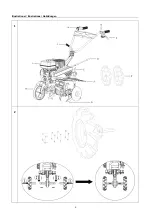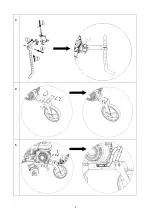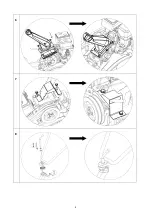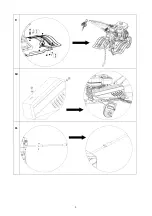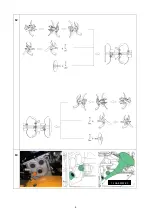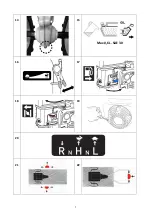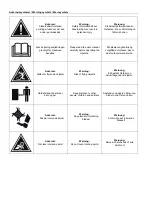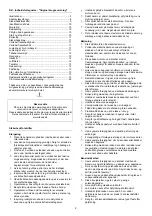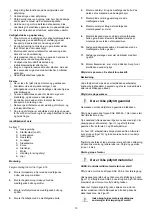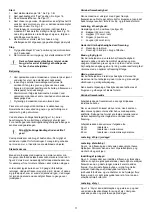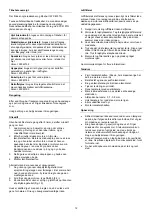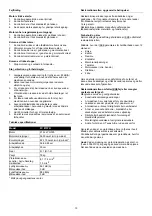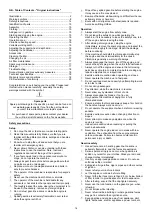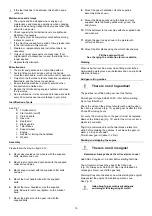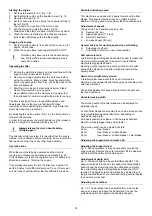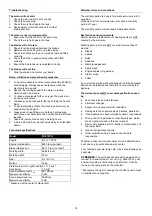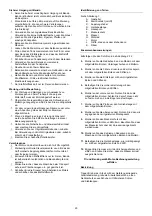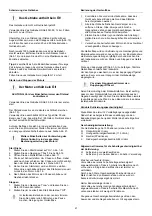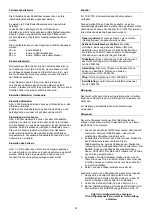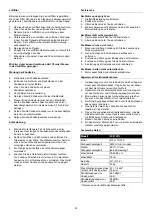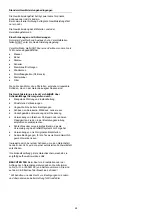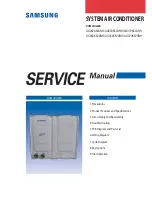
16
Starting the engine
1. Set the start switch to “On”. Fig. 1-B
2. Set the throttle control on the handle to max. Fig. 16
3. Open the fuel tap. Fig. 17
4. Set the choke arm to max. Move the choke lever fully to
the left. Fig. 18
The choke is not required if the motor is hot.
5. Pull the start cord to start the motor. Fig. 19
Always feed the start cord back into the motor by hand.
6. When the motor is started, set the choke to minimum
(fully to the right) Reduce the throttle slightly.
Stopping the engine
1. Set the throttle control to “low” and let the motor run for
approx. 30 seconds.
2. When the engine idles, push the start switch to “Off”.
Vibrations may travel up into the handle during
use. We therefore recommend taking a break
every 30 minuttes.
Operating the tiller
Ensure the machine is placed on a level surface with the
support wheel lowered prior to start.
Remove all foreign objects from the work area before
using the machine. Stones, glass, branches and similar
items may damage the tiller. Also, check the bolts on the
tiller are tightened.
Start the motor as per the instructions below. Stand
clear of the machine’s moving parts.
Never attempt to move the machine in any way other
than intended for normal use while the motor is running.
The tiller is designed for use in vegetable gardens and
flowerbeds. Ensure that you are familiar with these
instructions before operating the machine, in particular the
motor start and stop procedures.
By activating the clutch handle (Fig. 1-A), the tiller will move
forward or backwards.
In order to change gear, the clutch handle must be released,
before a new gear is selected with the gear rod
Always release the clutch handle before
changing gear!
Pay attention while reversing. It is important that the area is
cleared, for any obstacle before reversing. Never reverse the
tiller against a wall, tree or any other fixed obstacle.
Operation zone
While the machine is being operated and the motor is
running, do not leave the operation zone marked Fig. 22.
If it is necessary to leave the operation zone, for example to
attach an accessory, first stop the engine.
It is normally necessary to drive the tiller over a section of
earth 2-3 times from different directions. Do not till very wet
soil, as clods of earth will form that are difficult to break up.
Variable cultivating speed
This machine is equipped with 2 gears forward on the tiller
blades. This ensures the best result no matter in which
weather it is being used how however the soil conditions are.
Adjustment of speeds:
The gear rod has 5 positions (see Fig. 20)
R: Reverse (62 rpm)
H: High speed gear (113 rpm)
N: Neutral
(2
positions)
L:
Low speed gear (82 rpm)
General advises for working speed when cultivating:
H:
Cultivating in soft soil
L:
Cultivating in hard soil + use of accessories
Soft and moist soil:
A relatively high working speed should be used. It makes the
machine work forwards and it is easier to avoid that the
machine is digging itself down.
By using a higher speed, it prevents soil and mud to stick
between the blades and a better cultivating result will be
accomplished.
Hard soil / soil with many stones:
A relatively slow speed should be used. It makes the
machine work downwards and thereby gives a steadier work
with less vibrations.
The exact adjustment of speed should match the user and
the local conditions.
Variable working width
The working width of the tiller blades can be adjusted for
individual needs.
3 sets of tiller blades are mounted in each side. Each set can
be removed/attached with cotter bolts - depending on
needed working width.
It makes it possible to cultivate in narrow areas between
plants or cultivate bigger areas much faster.
The working width can be adjusted like this:
36 cm
Inner blades
62 cm
Inner middle blades
90 cm
Inner middle outer blades
Adjusting the support wheel / depth skid
Adjusting the support wheel
Fig. 4: During operation, it may be necessary to raise the
support wheel. Remove the outer cutterbolt, lift the wheel up
and fix it with the cutter bolt and pin again.
Adjustment of depth skid
Fig. 3: The depth skid can be set to different depths. The
deeper it extends into the soil, the deeper the tilling blades
will work and the slower the machine will advance. Setting
the correct tilling depth will significantly reduce the effort
required. The depth skid should always be adjusted to suit
the ground conditions. We recommend testing several depths
to see which works best.
Adjusting the handlebar
Fig. 1-J: The handlebar can be adjusted from side to side
and up and down by loosen the handlelock. Choose the
preferred position and tighten the handlelock again.
Содержание FX 815TG
Страница 3: ...3 3 4 5 ...
Страница 4: ...4 6 7 8 ...
Страница 5: ...5 9 10 11 ...
Страница 6: ...6 12 13 1 L SAE 80W 90 ...
Страница 7: ...7 14 15 Max 0 6 L SAE 30 16 17 18 19 20 21 22 ...
Страница 26: ...26 ...
Страница 27: ...27 ...
Страница 28: ...28 ...

